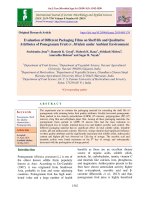Effect of different holding solutions on postharvest life of Iris (Iris orientalis Mill.)
Bạn đang xem bản rút gọn của tài liệu. Xem và tải ngay bản đầy đủ của tài liệu tại đây (263.94 KB, 5 trang )
Int.J.Curr.Microbiol.App.Sci (2019) 8(5): 2125-2129
International Journal of Current Microbiology and Applied Sciences
ISSN: 2319-7706 Volume 8 Number 05 (2019)
Journal homepage:
Original Research Article
/>
Effect of Different Holding Solutions on
Postharvest Life of Iris (Iris orientalis Mill.)
Mallika Thakur*, B.P. Sharma and Tamanna Verma
Department of Floriculture and Landscape Architecture, Dr YS Parmar University of
Horticulture and Forestry, Nauni, Solan 173230 Himachal Pradesh, India
*Corresponding author
ABSTRACT
Keywords
Iris orientalis Mill.,
holding solution,
Vase life
Article Info
Accepted:
17 April 2019
Available Online:
10 May 2019
The investigation entitled, “Effect of different holding solutions on postharvest life of Iris
(Iris orientalis Mill.)” was carried out at the experimental farm and laboratory of
Department of Floriculture and Landscape Architecture, Dr Yashwant Singh Parmar
University of Horticulture and Forestry, Nauni, Solan, in the year 2018. Experiment was
laid out in Completely Randomized Design with 10 treatments and 3 replications. Holding
cut spikes in solution comprising of Sucrose (3 %) + 8-HQC (300 ppm) + BA (150 ppm)
resulted in best treatment for most of the postharvest parameters such as amount of
solution consumed (116.58 ml), appearance of cut bloom (4.62), days taken for opening of
floret (2.40), floret diameter (14.94 cm), vase life (15.87 days) and minimum per cent
weight change/loss 23.13 %) of the cut spikes with 100 % bud opening.
Introduction
Iris orientalis Mill. is amongst species of
family Iridaceae in the genus of Iris. It falls in
the subgenus of Limniris and in series
Spuriae. It is a rhizomatous perennial plant,
native to Asia Minor, bearing beardless white
flowers with a yellow mark or blotch. It is
very hardy and has been known to naturalize
in various countries. It is widely cultivated as
an ornamental plant in temperate regions.
Being a member of an ethylene insensitive
family, it has a considerable potential to
become a prized ornamental cut flower (van
Doorn and Woltering, 2008; Zhong and
Ciafre, 2011). The majority of the genus
belongs to the rhizomatous group while only a
few to the bulbous types whereas only latter
types are grown commercially for cut flower
use when grown under greenhouse or in the
open. The international trade for cut flowers
has greatly been expanded in recent years.
Hence, there is an increased interest in
postharvest biology and biochemistry of cut
flowers. Most cut flowers have limited vase
life owing to their moisture content, delicacy
and tenderness. Hence, flowers and
ornamentals are most susceptible to
mechanical, physical damages and microbial
infections during and after harvest. There are
several pre and postharvest factors which
affects the longevity of cut flowers. The
2125
Int.J.Curr.Microbiol.App.Sci (2019) 8(5): 2125-2129
important factors, which affect postharvest
quality and longevity of cut flowers during
postharvest handling are time of harvest,
mode of harvesting, temperature, humidity,
light, ethylene production, flower sensitivity
and micro-organisms. In order to preserve the
best quality flowers after harvest and making
them tolerant to fluctuation in the
environmental conditions, treatments with
floral preservatives have been recommended.
Commonly most preservative solutions
consist of carbohydrates, germicides, ethylene
inhibitors, growth regulators and some
mineral compounds. Extension of vase life
and improvement of keeping quality of cut
flowers are important areas of research in the
postharvest sector of floriculture industry.
There is only scanty information available on
postharvest handling of cut iris. Hence
preservation of best quality flowers and
enhancement of postharvest life of cut iris is
an important area of research in the field of
floriculture. Therefore present study has been
undertaken with the objective to find out the
best holding solution for Iris (Iris orientalis
Mill).
Materials and Methods
The present investigation was carried out in
the laboratory of Department of Floriculture
and Landscape Architecture, Dr YS Parmar
University of Horticulture and Forestry,
Nauni, Solan during 2018. Uniform, healthy
and disease free rhizomes were selected and
used further for the present study. Planting
was done in beds of convenient length with a
width of 1.2 m raised about 15 cm from
ground level at a spacing of 20×20 cm. The
cut spikes of uniform size were harvested in
the morning hours (7-8 am) with the help of a
sharp secateur. After harvesting, these spikes
were immediately placed in a bucket
containing water. The stage of harvesting for
cut iris was „pencil tip‟. After harvesting, cut
spikes were taken to the laboratory in the
department of Floriculture and Landscape
Architecture for conducting the experiment.
The lower leaves from cut spikes were
removed retaining 3-4 upper leaves. A
slanting cut was given at the base of each cut
spike in such a manner that the final cut spike
length remained 55 cm.
Results and Discussion
Cut spikes consumed maximum amount of
solution (116.58 ml) when held in T7
comprising of Sucrose (3 %) + 8-HQC (300
ppm) + BA (150 ppm). However in T1
(distilled water) cut spikes consumed
minimum amount of holding solution (Table
1). It was observed during investigation that
cut spikes put in the various holding solutions
consumed significantly larger amount of
solution over spikes kept in the control
(distilled water). The results are in consent
with the findings of Marousky (1972) who
confirmed that 8-HQC inhibited stem
plugging by reducing the pH of solution and
thereby increased the conductivity of stems
hence, cut flowers absorbed more amount of
solution. Similar results were reported by
Dastagiri (1013) in chincherinchee and Murry
(2014) while working in tuberose.
The cut flowers retain maximum freshness
and colour with the highest score of 4.62
when held in T7 i.e. Sucrose 3 % + 8-HQC
(300ppm) + BA (150 ppm). On contrary, cut
flowers when held in distilled water (T1)
recorded poor appearance with minimum
score of 3.70. All holding solutions tested in
this experiment resulted in enhanced overall
appearance of flowers over control. However,
the best appearance was registered in case of
T7 i.e. Sucrose (3 %) + 8-HQC (300 ppm) +
BA (150 ppm). This might be due to the fact
that sucrose supplied the substrate for
continuous respiration (Morousky, 1971),
maintained mitochondrial structure and
function whereas 8-HQC prevented vascular
2126
Int.J.Curr.Microbiol.App.Sci (2019) 8(5): 2125-2129
blockage, cause stomatal closure and
improved water balance. This may also be
attributed to presence of BA in solution which
has
increased
quantum
yield
of
photosynthesis in the leaves and helped in
retaining natural flower colour for longer
duration. This may be because of the fact that
BA delays senescence by improving the
membrane stability of cut flowers (Guo et al.,
1997). The result got support from the
findings of Manikrao (2007) in alstroemeria,
Dastagiri (2013) in chincherinchee, Murry
(2014) in tuberose and Chunne (2015) in
hydrangea.
The cut spikes took minimum days for
opening i.e. 2.40 days when held in T7 namely
Sucrose 3 % + 8-HQC (300ppm) + BA (150
ppm). On contrary, the cut spikes held in
distilled water (T1) took maximum days (4.33
days) for opening of first floret. It was
observed that florets in all the holding
solutions opened earlier as compared to
control (distilled water). Particularly in the
presence of lower levels of BA, florets took
maximum number of days to open when held
in distilled water. Besides sugars and
biocides, cytokinins also stimulates bud
opening via auxin and proton secretion. This
proton secretion acidifies the petal cell walls
which
allow
expansion
to
occur
(Bhattacharjee, 1999). The results got support
from finding of Dastagiri (2013) in
chincherinchee.
Largest floret diameter (14.94) was recorded
in cut spikes treated with T7 i.e. Sucrose 3 %
+ 8-HQC (300ppm) + BA (150 ppm).
Minimum floret diameter (13.43 cm) was
recorded in those cut spikes held in distilled
water (T1). This increase in flower diameter
may be due to the ability of cytokinins in cell
enlargement which ultimately increased the
flower diameter. It is well documented that
the accumulation of carbohydrates and more
water uptake had direct effect on increase in
the cell volume. The petal cell of untreated
flowers with poor water uptake might have
been flaccid and deplasmolysed, leading to
reduced size of cells and that of petals.
Moreover, sucrose availability might have
facilitated higher rate of respiration necessary
for cell division, cell enlargement and
providing of „C‟ skeleton for the tissue
structure contributing to petal expansion and
formation of cell constituents and, thus,
caused increased flower diameter (Ho and
Nichols, 1977) in rose. Further addition of BA
in solution has helped to enhance longevity
and delayed catabolic activities which
increased the flower quality and resulted in
availability of more substrates to the flower.
These results also got support from findings
of Lukaszewska (1995) in rose, De and
Bhattacharjee (1999) in rose cv. „Super Star‟,
Bhatia (2000) in carnation cvs. „Impala‟ and
„Purple Choppin‟, Singh et al., (2000) and
Nagarajuna et al., (2002) in tuberose,
Dastagiri (2013) in chincherinchee and Murry
(2014) in tuberose.
It is clear from data presented in Table 1 that
cut spikes when held in holding solution
containing Sucrose 3 % + 8-HQC (300ppm) +
BA (150 ppm) i.e. T7 resulted the longest vase
life (15.87 days) whereas, minimum vase life
(9.93 days) was recorded in those cut spikes
held in distilled water (T1). During the
investigation, it was observed that cut spikes
kept in different holding solutions exhibited
longer vase life as compared to those held in
distilled water (control). This may be
attributed to the reduced stem conductivity.
As there are many chances of growth of
different micro-organisms in distilled water
which may check/reduce the proper
conductivity of water (Accati et al., 1981) and
results in early senescence. The superiority of
8-HQC in enhancing various postharvest
parameters has also been verified in present
studies. The main cause of decline in solution
uptake is microbial growth in vase water that
2127
Int.J.Curr.Microbiol.App.Sci (2019) 8(5): 2125-2129
caused reduction in absorption of solutions
(Halevy and Mayak, 1981) besides 8-HQC
has been suggested for prolonging vase life of
cut flowers by inhibiting bacterial growth and
stem blockage. The results obtained got
support from the studies of Manikrao (2007)
in alstroemeria, Kim and Lee (2010) in iris
and Chunne (2015) in hydrangea.
Table.1 Effect of different holding solutions on postharvest life of Iris (Iris orientalis Mill.)
Treatment
T₁
T2
T3
T4
T5
T6
T7
T8
T9
T10
CD0.05
Holding solutions
Distilled Water (control)
Sucrose 3 % + 8-HQC (200 ppm) + BA (50 ppm)
Sucrose 3 % + 8-HQC (200 ppm) + BA (100 ppm)
Sucrose 3 % + 8-HQC (200 ppm) + BA (150 ppm)
Sucrose 3 % + 8-HQC (300 ppm) + BA (50 ppm)
Sucrose 3 % + 8-HQC (300 ppm) + BA (100 ppm)
Sucrose 3 % + 8-HQC (300 ppm) + BA (150 ppm)
Sucrose 3 % + 8-HQC (400 ppm) + BA (50 ppm)
Sucrose 3 % + 8-HQC (400 ppm) + BA (100 ppm)
Sucrose 3 % + 8-HQC (400 ppm) + BA (150 ppm)
Amount of
vase solution
consumed
(ml)
Appearance
(Score out of
5)
Days taken
for opening
of floret
(days)
Floret
diameter
(cm)
Vase
life
(days)
Per cent
weight
change
(loss)
65.47
70.48
77.53
3.70
3.78
3.86
4.33
3.27
3.13
13.43
13.83
13.90
9.93
10.87
11.67
47.42
39.13
39.30
82.35
92.21
3.90
3.95
2.93
2.60
13.93
14.08
13.07
13.67
40.40
34.72
103.22
116.58
105.27
4.38
4.62
4.51
2.53
2.40
2.67
14.29
14.94
14.38
14.27
15.87
14.87
32.58
23.13
25.21
92.24
86.48
4.23
4.11
2.53
2.47
14.26
14.12
14.13
13.80
27.62
29.36
2.70
0.04
0.18
0.09
0.31
0.92
It is evident from Table 1 that minimum
weight loss (23.13 %) was observed in cut
spikes when held in treatment T7 i.e. Sucrose
3 % + 8-HQC (300ppm) + BA (150 ppm)
whereas, cut spikes placed in holding solution
containing distilled water (T1) recorded
maximum weight loss (47.42 %) and it was
found to be significantly higher than other
treatments. The above findings might be due
to the effect of sucrose and 8-HQC in
inducing the higher uptake of vase solution,
less water loss and decrease in the aperture
size of leaf stomata. Further, 8-HQC
enhanced water uptake by avoiding blockage
of xylem tissues which resulted in higher
fresh weight. The results are in conformity
with the findings of Murry (2014) in tuberose
and Chunne (2015) in hydrangea. Keeping in
view the above findings, it can be concluded
that holding solution comprising of Sucrose
(3 %) + 8-HQC (300 ppm) + BA (150 ppm)
improved the overall longevity of cut iris.
References
Accati E, Mayak S and Gentile IA. 1981. The
role of bacterial metabolites in affecting
water uptake by carnation flowers. Acta
Horticulturae 113:153-158.
Bhatia S. 2000. Studies of Pulsing and
Storage of Carnation Cut Flowers. MSc
Thesis. Department of Floriculture and
Landscape Architecture, Dr YS Parmar
University of Horticulture and Forestry,
Solan. 47p.
Chunne T. 2015. Studies on Postharvest
Handling of Hydrangea (Hydrangea
macrophylla Thunb.) as Influenced by
Pre-harvest Fertilization. MSc Thesis.
Department
of
Floriculture
and
Landscape Architecture, Dr YS Parmar
University of Horticulture and Forestry,
Solan. 67p.
Dastagiri D. 2013. Studies on Postharvest
Handling
of
Chincherinchee
(Ornithogalum thyrsoides Jacq.). MSc
Thesis. Department of Floriculture and
2128
Int.J.Curr.Microbiol.App.Sci (2019) 8(5): 2125-2129
Landscape Architecture, Dr YS Parmar
University of Horticulture and Forestry,
Solan. 60p.
De LC and Bhattacharjee SK. 1999. Effect of
chemicals for tight bud opening of rose
cv. „Super Star‟ at different stages of
maturity. Annals of Agricultural
Research 20:206-211.
Doorn WG and Woltering EJ. 2008.
Physiology and molecular biology of
petal
senescence.
Journal
of
Experimental Botany 59:453-480.
Guo WM, Zhang ZH and Fang WM. 1997.
Effect of 6-BA on physiological
response of cut chrysanthemum during
vase periods. Acta Horticulturae Sinica
24:364-368.
Halevy AH and Mayak S. 1981. Senescence
and postharvest physiology of cut
flowers. Horticultural Review 32:59143.
Ho LC and Nichols R. 1997. Translocation of
14C sucrose in relation to change in
carbohydrate content in rose corollas
cut at different stages of development.
Annals of Botany 41:227-242.
Kim YA and Lee JS. 2010. Effect of
cycloheximide and holding solution on
vase life of cut „Blue Magic‟ iris
flowers according to the flower
development and opening stages.
Korean Journal of Horticultural
Science and Technology 28:790-795.
Lukaszewska AJ. 1995. Distribution of sugars
in tulip flower parts as affected by
Ethrel and GA3. Acta Horticulturae
405:351-355.
Manikrao DR. 2007. Studies on Possible
Alternatives of Silver Thiosulphate in
Postharvest Handling of Alstroemeria
and Carnation Cut Flowers. PhD
Thesis. Department of Floriculture and
Landscape Architecture, Dr YS Parmar
University of Horticulture and Forestry,
Solan. 119p.
Marousky FJ. 1971. Inhibition of vascular
blockage and moisture retention in cut
roses
induced
by
pH,
8hydroxyquinoline citrate and sucrose.
Journal of the American Society for
Horticultural Science 96:38-41.
Marousky FG. 1972. Water relations, effect of
floral preservatives on bud opening and
keeping quality of cut flowers.
HortScience 7:114-117.
Murry NA. 2014. Postharvest Handling of
Tuberose (Polianthes tuberosa Linn.)
cv. „Double‟. MSc Thesis. Department
of
Floriculture
and
Landscape
Architecture, Dr YS Parmar University
of Horticulture and Forestry, Solan.
64p.
Nagarjuna HT, Narayanagowda JV and
Nagaraja GS. 2002. Effect of pulsing
with sucrose on vase life of tuberose cv.
„Double‟. Crop Research Hisar 23:349353.
Zhong Y and Ciafre C. 2011. Role of ABA in
ethylene-independent
Iris
flower
senescence.
2011
International
Conference on Food Engineering and
Biotechnology IPCBEE vol.9, IACSIT
Press, Singapore.
How to cite this article:
Mallika Thakur, B.P. Sharma and Tamanna Verma. 2019. Effect of Different Holding
Solutions on Postharvest Life of Iris (Iris orientalis Mill.). Int.J.Curr.Microbiol.App.Sci. 8(05):
2125-2129. doi: />
2129
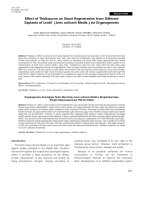

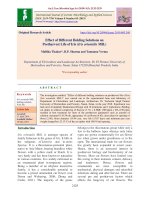
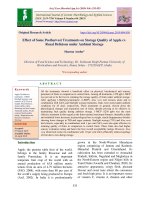

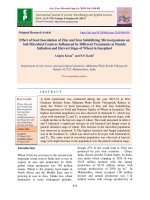
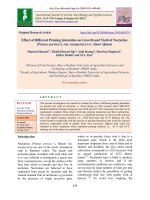

![Effect of different plant growth regulators on shooting of stem cuttings in dragon fruit [Hylocereus undatus (Haworth) Britton & Rose]](https://media.store123doc.com/images/document/2020_01/09/medium_isb1578564896.jpg)
